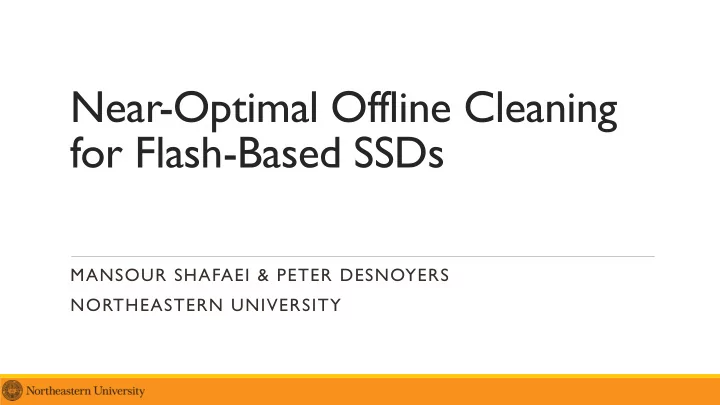

Near-Optimal Offline Cleaning for Flash-Based SSDs MANSOUR SHAFAEI & PETER DESNOYERS NORTHEASTERN UNIVERSITY
Outline Background Problem definition Approach Evaluation Conclusion 2
Background Performance of Flash-Based SSDs dominated by Cleaning costs (Write Amplification) The number of internal copies required before erasing blocks Different translation layers and cleaning algorithms have been evaluated Experimentally Analytically in some cases No one knows the performance limits (room for improvement)! 3
Problem Definition A single write frontier device with demand cleaning 1 block is selected and cleaned when running out of free pages The entire trace is available What is optimal sequence of block selection? 4
Greedy Cleaning Optimal (online) for uniform random B1 B2 workloads 1 6 Clean B1, then B2 (Non-Greedy) 2 7 B1 B2 3 8 1 4 4 9 2 5 5 10 Trace: 4, 5, 6, 7, 8, 9, 10 3 X 4 1 X X 5 2 X X 4 3 Clean B2, then B1 (Greedy) 5 7 6 8 5
Optimal Cleaning Formulated as a decision problem B9 B4 Tree search problem B7 B6 Having choice of >1 block for cleaning at each of O(trace_length) different cleaning points NP-Hard (we believe) No proof is known! 6
Complexity Reduction In worst case, any decision choice in a tree may potentially lead to an optimal cleaning Heuristics to mitigate the complexity of search tree Graph pruning Using stochastic search Monte Carlo Tree Search (MCTS) 7
Graph Pruning Metrics 1. Instantaneous WA (i.e. # valid pages to be copied) Greedy – choose only based on instantaneous WA Any optimal cleaning consists of at least one greedy choice B4 B9 B7 WA(B6)>WA(B3) B6 B3 8
Graph Pruning Metrics (Cont.) 2. Ultimate future WA The number of static pages in the newly created block Will need to be copied no matter how long we delay cleaning A lower bound on the WA of the selected block when re-selected for cleaning in the future 9
Graph Pruning Metrics (Cont.) 3. Page death rate Rate of dying for pages inside the newly created block The higher the death rate the lower the chance that a block is selected for future cleanings before reaching to its static state 10
Graph Pruning Metrics (Cont.) 4. Absolute death time When space will be available in the newly created block for future cleaning The earlier the better Available for more number of cleanings 11
Graph Pruning Algorithm Start with Greedy blocks with: Minimum future write amplification Highest death rate Earliest absolute death time Add Non-greedy blocks that are “better” (for any of 3 metrics) than all previously selected blocks Examine in order of instantaneous WA 12
Monte Carlo Tree Search Traditional search algorithms e.g. DFS from O(|E|+|V|) 13
Evaluation Implemented in Python supporting Optimal and near-optimal cleanings DFS and MCTS as graph traversal options Greedy and random block selections for simulation step in MCTS 4 synthetic + 10 MSR traces Effects of used heuristics Comparison with Greedy 14
Graph Pruning Effect Complete graph vs pruned graph traversal using DFS 15
MCTS vs DFS For pruned tree Up to ~97% reduction in terms of number of traverses No loss in 100 90 accuracy 80 REDUCTION (%) 70 60 50 40 30 20 10 0 Uniform Normal Exponential Gamma Series1 79 24.5 97.5 94.4 16
MSR Traces 17
Near-Optimal vs Greedy 18
Near-Optimal vs. Dual WF Hot/Cold 30-85% vs. <5% improvements over Greedy 19
Conclusions Near-optimal cleaning an approximation of optimal offline cleaning Graph pruning + MCTS Modest improvements over online Greedy for 1-WF + demand cleaning << 2WF online with hot/cold segregation Efficient cleaning a matter of data placement for incoming/cleaned data rather than block selection for cleaning 20
Thank Y ou! 21
Backup 22
Recommend
More recommend